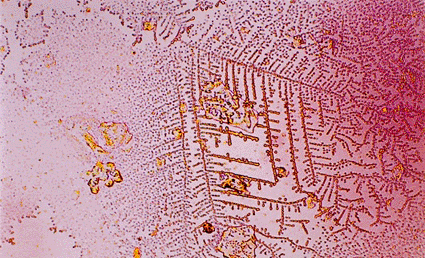Saliva: New Diagnostic Alternative to Blood?
By Labmedica staff writers
Posted on 01 Apr 2008
Posted on 01 Apr 2008

Image: Light micrograph of human saliva (Photo courtesy of CMSP).
The term saliva is increasingly reserved by scientists only for the salivary gland secretions (ductal saliva). This new definition is significant because of the emerging theory that the mix of proteins in ductal saliva tracks closely with that of blood, making saliva a potential diagnostic stand-in for blood.
The saliva of 23 adults, which included men and women of various racial backgrounds, was tested by scientists from across the United States. Although the sample size was small, the findings could lead to future study of people who are healthy and those who suffer from any one of a variety of illnesses.
To construct a credible protein list for saliva, three teams of scientists used competing techniques both to capture the greatest number of protein candidates for the list and to lend extra credibility to those found using different methodologies. Each team subjected saliva collected from patients to some form of mass spectrometry, which determined the identity of proteins based on measurements of their mass and charge.
The teams succeeded in identifying the entire proteome in parotid and submandibular/sublingual saliva. The results indicated that more than one-third of saliva proteins were found in the blood proteome as well. Comparison of these proteins against known protein pathways and other proteomes provided a first glimpse of the function of the core proteins. A number of the salivary proteins were found to match proteins with known roles in Alzheimer's, Huntington's, and Parkinson's diseases; breast, colorectal, and pancreatic cancer; and type I and II diabetes. Specifically, most of the proteins were found to be part of signaling pathways, which is central to the body's response to (and therefore diagnostic of) system-wide diseases. These findings were reported online in the March 25, 2008, issue of the Journal of Proteome Research.
Determining the salivary proteome is only the first step toward salivary-based diagnosis and treatment. The protein information is already being incorporated into microarray technology, a high-speed test that can determine the levels of multiple proteins during disease progression. Related work is underway under within the National Institutes of Health (NIH; Bethesda, MD, USA)-funded Bioengineering Nanotechnology Initiative to design biochips, nanoscale computer chips packed with salivary protein chains. Protein probes on the chip react with proteins in a saliva sample, for instance, from the mouth of someone with oral cancer, and inform a computer about which proteins are present.
The U.S. National Institute of Dental and Craniofacial Research (NIDCR), part of the National Institutes of Health, funded the current study. The saliva proteome study represents a consortium effort with scientists at The Scripps Research Institute (La Jolla, CA, USA), University of Rochester (Rochester, NY, USA), University of Southern California (Los Angeles, CA, USA), University of California at San Francisco (San Francisco, CA, USA), and University of California at Los Angeles (Los Angeles, CA, USA).
James E. Melvin, D.D.S., Ph.D., director of the Center for Oral Biology at the University of Rochester Medical Center (Rochester, NY, USA), said, "Our work, and the work of our partners, has shown that salivary proteins may represent new tools for tracking disease throughout the body--tools that are potentially easier to monitor in saliva than in blood.”
Related Links:
The Scripps Research Institute
National Institutes of Health
University of Rochester














